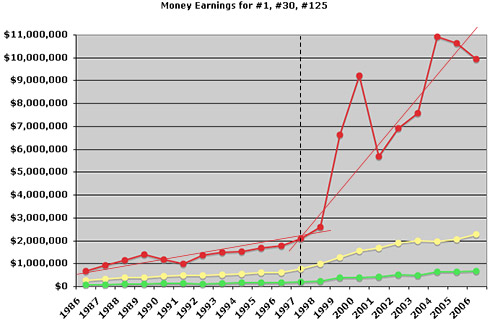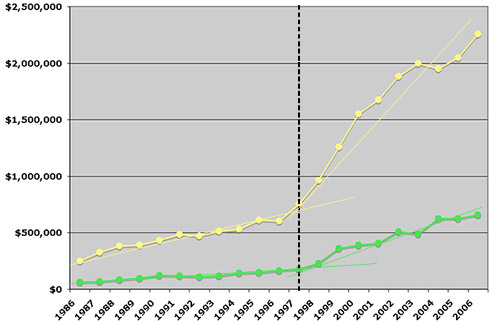 With his win this week at the Wachovia Championship, Tiger Woods surpassed the $4 million mark for the eighth straight year. And it’s only May!
With his win this week at the Wachovia Championship, Tiger Woods surpassed the $4 million mark for the eighth straight year. And it’s only May!
It’s unquestioned that Tiger Woods has had a dramatic effect on the game, and certainly on the money list. Though you can ask the old codgers about the days winning barely paid for the gas to the next tournament, the modern-day PGA professional must make over half a million dollars just to keep his Tour card!
The money list is one of the few stats that measure actual performance on the course. It’s also one of the few areas in which we can statistically and visibly see Tiger’s effect on the game of golf.
Let’s have a look.
PGA Tour Money List
The PGA Tour has many significant spots on the money list. For the sake of this column, we’ll include the leader, the last person to qualify for the Tour Championship (#30), and the last person to keep his PGA Tour card (#125). Let’s have a look at how these numbers stack up from 1986 to last year, a span of 21 years.
Year Leader #30 #125 ---- -------- -------- -------- 1986 $0.65 M $252,827 $63,395 1987 $0.93 M $327,250 $69,094 1988 $1.1 M $380,651 $83,590 1989 $1.4 M $391,855 $99,454 1990 $1.1 M $435,690 $123,908 1991 $0.98 M $485,023 $117,549 1992 $1.3 M $472,626 $109,742 1993 $1.5 M $513,072 $120,041 1994 $1.5 M $533,201 $142,515 1995 $1.6 M $611,700 $149,280 1996 $1.8 M $604,382 $167,852 1997 $2.0 M $752,077 $179,273 1998 $2.5 M $964,302 $228,304 1999 $6.6 M $1.25 M $362,893 2000 $9.1 M $1.5 M $391,075 2001 $5.6 M $1.7 M $406,352 2002 $6.9 M $1.9 M $509,845 2003 $7.5 M $2 M $487,495 2004 $10.9 M $2 M $623,262 2005 $10.6 M $2 M $626,736 2006 $9.9 M $2.3 M $660,898
The average earnings of these three positions from 1986-1996 are $1.3 M, $455,298, and $113,311. The average earnings of these three positions from 1997-2006 are $7.2 M, $1.6 M, and $447,613. Charted, that is:
Years Leader #30 #125 --------- -------- -------- -------- 1986-1996 $1,274,987 $455,298 $113,311 1997-2006 $7,211,183 $1,634,260 $447,613
The $1 Million Mark
In 1989, Curtis Strange became the first player on the PGA Tour to surpass $1 million in earnings in a single season. Strange won four times in 1989, including the U.S. Open!
In stark contrast, new millionaires pop up just about every week on the PGA Tour today. Of the non-opposite field events on the PGA Tour in 2007, only two pay the winner less than $800,000: the John Deere Classic (which pays $738,000) and the US Bank Championship ($720,000).
Though not opposite field events, these events fall one and two weeks short of the British Open, an event for which many of the top players fly to Europe early in order to prepare.
It was not too long ago that only the biggest of the PGA Tour events paid out over $1 million to the winner. In 2007, there are nearly 20 events on the schedule where the winner rakes in $1 million or more. Topping the list of 2007 PGA Tour paydays is the Players. The winner of this year’s go-round in Ponte Vedra will take home a cool $1.44 million!
Million Dollar Winners ---------------------- 1986: 0 1987: 0 1988: 1 1989: 2 1990: 2 1991: 0 1992: 4 1993: 5 1994: 6 1995: 9 1996: 9 1997: 18 1998: 26 1999: 36 2000: 45 2001: 46 2002: 61 2003: 72 2004: 77 2005: 78 2006: 93
As recently as 1991, nobody earned $1M on the PGA Tour. Six years later – Tiger’s first full year on Tour – the PGA Tour minted 18 millionaires. Last year, 93 golfers won over $1M in prize money.
The Tiger Effect

Official earnings for the past 21 years are graphed above. The red line indicates the leader’s prize money, the yellow the #30 finisher, and the green the guy who barely kept his PGA Tour card.
The dashed line represents 1997, Tiger’s first full year on the PGA Tour (and the year he won his first major, The Masters, by 12 shots over Tom Kite). 1997 also marked the year someone earned at least $2M in prize money (Tiger earned $2,066,833).
Much has been made of Tiger’s effect on purses and money paid to winners. The red lines in the graph above indicate trend lines. The first from 1986-1998. The second from 1997-2006. Notice the change in slope. What’s the cause?
When the PGA Tour negotiated its last TV contract in 2001, Tiger-mania was in full scream and ratings were soaring. Betting that pro golf was the next mainstream sport, networks and cable channels forked over a total of $850 million in rights fees between 2003 and 2006 – a 50% hike over the preceding four-year deal. The money our favorite professional golfers earn each year started to skyrocket from there.
In 1997, Tiger Woods earned just north of $2M to lead the money list. By 2003, that amount barely qualified a golfer to play in the season-ending Tour Championship. How long will it be until a golfer needs to earn $2M just to keep his PGA Tour card?
Let’s have a look:

By the looks of this graph, it appears we could require $1M in earnings to keep your card by 2010 and $2M as soon as 2025!
Where To Now?
Each season, the top 125 on the season ending money list earn their full-time card for the following season. How much will it take this year to retain that card this year? As of the Wachovia Championship, there are already 31 players with over $1 million earned through the first part of 2007. The current #125 has earned $222,650. At this rate, I expect to see the 125 mark falling just short the $750,000 point at season’s end.
Between 1996 and 2006, prize money earnings in the #125 position have increased 393.74%. The #30 guy’s earnings have gone up 373.33%. The top spot – “Tiger’s Spot”? Why, that’s only seen an increase of 558.46%!
Suffice to say, not only are these guys good, but they’re pretty well off, too.

Is the FedEx bonus “official money”? We could see a $20 M winner this year!
Brian, actually the FedEx bonus does not count toward official money, the overall playoff winner gets the FedEx Cup Trophy, a glass bowl designed by Tiffany & Co., and a $10 million annuity. The prize money counts toward a player’s season earnings, but the annuity does not.
Prize money for the “playoff” events leading up to the final winner being declared does count however so we’ll surely see the top players on the money list increasing their bank accounts quite measurably.
It would be interesting to compare the total percentage of salaries paid in baseball, footbal, basketball, to the increase in purses on the PGA tour. You could make the case that any percentage increase exceeding that of other sports is mostly related to Tiger. If other sports have increased as greatly than it could be argued the Tiger effect less than assumed.
“ask the old codgers about the days winning barely paid for the gas to the next tournament”
You can ask the old codgers a question about anything and they will bemoan about how things were tougher in their day. how far they could hit the ball when they wer young without modern technology, how well they could swing without video lessons etc etc. Old codgers really are a waste of oxygen in any debate as they will do nothing but whinge about how tough it used to be. I think it might be the dementia talking most of the time.
Do most touring pros make a decent living playing golf? Some years ago I read an article indicating that most struggle and seldom make much money. We obviously see the big moneymakers, but what about the general pool of talent and their monetary success?